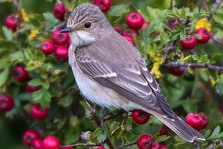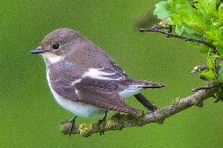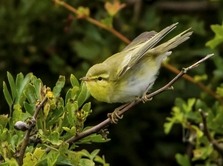

Biodiversity
Action
Plan
Four Migratory Woodland Local Priority Bird Species
Woodland also supports migrant breeding birds, coming to Barnsley in the summer. Very small numbers of the migratory Tree Pipit and Wood Warbler still breed in the upland fringe woodlands and Pied and Spotted Flycatcher are becoming increasingly scarce. Their decline may also be due to issues on their migration routes or wintering grounds.
Spotted Flycatcher
UKBAP 2007 Priority Species
NERC Section 41 Species of Principal Importance
BoCC5 Red List [IUCN2 NT]
General protection W&C Act
Spotted Flycatcher, a streaky, grey-brown bird, darts out from a perch to catch flying insect prey mid-air.
In Barnsley, Spotted flycatcher is now scarce and local, mainly west of the M1
They are found in woodland with open glades, parks and mature gardens.
It eats large flying insects such as moths, butterflies and craneflies.
Conservation measures
- Woodland management to maintain open areas and promote insect numbers
- Retain Ivy on trees and set up open-fronted nest boxes.
- Measures to reduce predation
- Monitoring of known sites
Habitats
- Mixed Deciduous Woodland
- Open wooded parkland
- Gardens with mature trees
They are migrant breeding birds arriving late April to early May.
They nest in tree cavities, on ledges and climbing plants, and use open-sided nest boxes.
Its decline may be due to poorer woodland quality, a lack of large flying insects and a loss of nesting habitat.
Predation mainly by Jay may be a factor, especially in woodland.

Conservation
- Maintain suitable habitat including by limited grazing
- Retain clear areas and prevent encroachment of scrub
- Retain prominent trees as song-posts.
Habitats
- Upland oakwood
- Mixed deciduous woodland
- Young & clear-fell plantations
The migrant Tree Pipit, arrives from mid April and nests on the ground from May to August.
Their decline may be due to issues on their migration routes or wintering grounds.
It may also be due to changes in woodland structure with less management of wooded areas, plantations maturing, and the availability of ‘song-post’ trees.
Tree Pipit
UKBAP 2007 Priority Species
NERC Section 41 Species
BoCC5 Red List
General protection W&C Act
Tree pipits feed on the ground, but sing from trees or bushes in a parachuting flight.
Scarce and possibly in decline in Barnsley, small numbers breed in open scrub or wooded places in upland areas.
They need trees in low densities and feed mainly on small insects and other invertebrates.
Conservation measures
- Maintain habitat structure in key woodland habitat:
- Maintain sparse ground vegetation through low intensity grazing
Habitat
- Upland oakwood
- Mixed deciduous woodland
- Beech Plantations
A summer migrant, they are present from April to August.
Their breeding season begins in May. They nest close to the ground, usually in scrub.
Their decline may be due to issues on their migration routes or wintering grounds. Here they may be affected by changes in their woodland habitat
Wood Warbler
UKBAP 2007 Priority Species
NERC Section 41 Species
BoCC5 Red List [IUCN2 VU]
General protection W&C Act
It is a migrant breeding bird arriving in April to early May.
They mainly eat insects and caterpillars but also fruit and seeds in late summer.
They use cavities in mature trees for nesting and will readily use nest boxes.
The causes of its decline may involve a lack of insect prey, competition and predation.
Pied Flycatchers fly out from trees to catch insects.
The male, black above and white underneath, has a bold white patch on its folded wing. Females are browner.
In the Barnsley area, Pied Flycatcher is scarce and local to broadleaved woods close to the moorland fringe around Langsett and Wharncliffe.
Conservation measures
- Maintain mature open broadleaved woodland in upland areas.
- Provide nest boxes in suitable sites and seal nest box holes until April to keep available
Habitats
- Mixed Deciduous Woodland in upland areas
- Upland Oakwood
Pied Flycatcher
BoCC5 Amber List [IUCN2 NT]
General protection W&C Act

Wood Warblers have a yellow
throat and eye stripe.
They are found in deciduous woodland under closed canopies with only a little shrub layer.
Scarce and possibly in decline in Barnsley, small numbers breed in mature oak woods and beech plantations in upland areas.
They feed on insects & spiders.

Tree pipit image needed